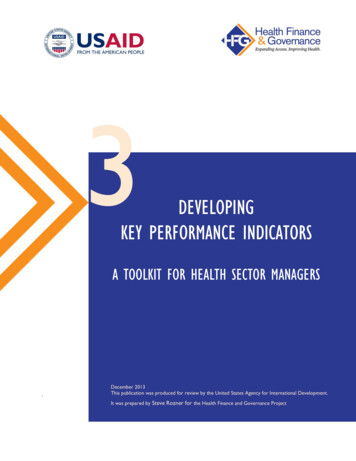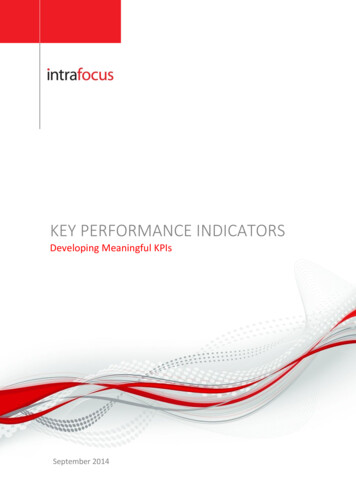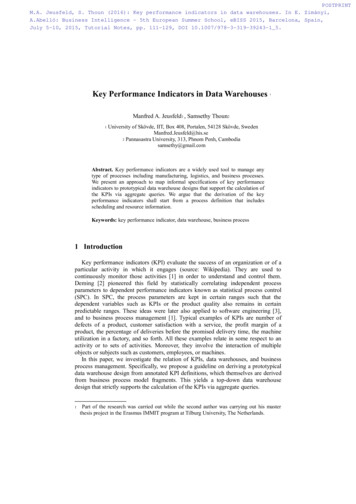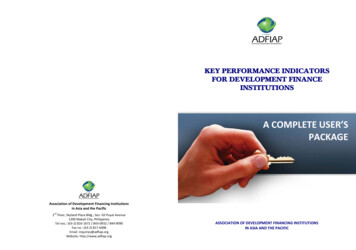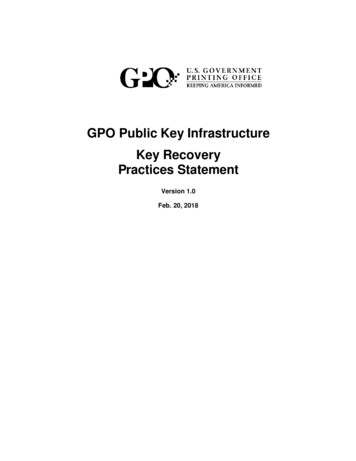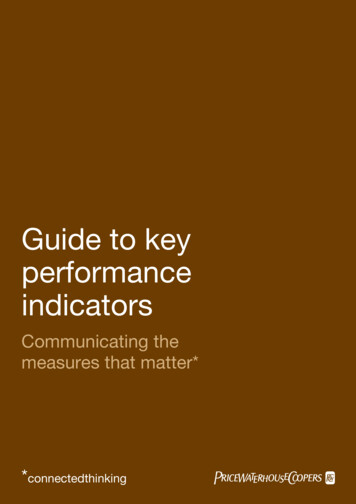
Transcription
Guide to keyperformanceindicatorsCommunicating themeasures that matter**connectedthinkingpwc
Although narrative reporting requirements remainfluid, reporting on KPIs is here to stay. I welcomethis publication as a valuable contribution tohelping companies choose which KPIs to reportand what information will provide investors with areal understanding of corporate performance.Peter ElwinHead of Accounting and Valuation ResearchCazenove EquitiesUsing management’s own measures of successreally helps deepen investors’ understanding ofprogress and movement in business. Whethercontextual, financial or non-financial, these datapoints make the trends in the business transparent,and help keep management accountable. Theillustrations of good practice reporting on KPIsshown in this publication bring alive what isrequired in a practical and effective way.Roger HirstDirector of European Equity ResearchBear Stearns International
IntroductionNarrative reporting - whether in the form of an Operating andFinancial Review (OFR), Management Discussion and Analysis(MD&A), a Business Review or other management commentary - isvital to corporate transparency. Key performance indicators (KPIs),both financial and non-financial, are an important component of theinformation needed to explain a company’s progress towards itsstated goals, for all of these types of narrative reporting.But despite this fact, KPIs are not well understood. What makes aperformance indicator “key”? What type of information should beprovided for each indicator? And how can it best be presented toprovide effective narrative business reporting?This publication continues our seriesof practical guides on aspects oftransparent corporate reporting.Following on from our “Guide toforward-looking information”,we address the UK legislativerequirement for KPIs, as well asproviding answers to the questionshighlighted above.In responding to these questionswe don’t just look at the guidancecurrently available on the detailsof narrative reporting and KPIs.Instead, like the previous guides inour series, this publication drawson the wealth of expertise thatPricewaterhouseCoopers has gainedthrough several years of researchamong investors and directors,and through initiatives such asValueReportingTM and the BuildingPublic Trust Awards.As a result, we seek to illustratewhat good reporting of KPIs lookslike. We bring to life our suggestionsregarding both the content andpresentation of KPIs with a collectionof good practice examples, drawnfrom the UK and elsewhere.Together, these practical examplesshow how some companies arealready making a virtue of reportingthe measures that are critical toan understanding of businessperformance and delivery againsttheir chosen strategy.This publication contains certain text and information extracted from third party documentation and so being out of context from the original third party documents;readers should bear this in mind when looking at this publication. The copyright in such third party text and information remains owned by the third parties concerned, andPricewaterhouseCoopers expresses its sincere appreciation to these companies for having allowed it to feature their information. For a more comprehensive view on eachcompany’s communication, please read the entire document from which the extracts have been taken. Please note that the inclusion of a company in this publication does notimply any endorsement of that company by PricewaterhouseCoopers nor any verification of the accuracy of the information contained in any of the examples.This publication has been prepared for general guidance on matters of interest only, and does not constitute professional advice. You should not act upon the informationcontained in this publication without obtaining specific professional advice. No representation or warranty (express or implied) is given as to the accuracy or completeness ofthe information contained in this publication, and, to the extent permitted by law, PricewaterhouseCoopers LLP, its members, employees and agents accept no liability, anddisclaim all responsibility, for the consequences of you or anyone else acting, or refraining to act, in reliance on the information contained in this publication or for any decisionbased on it. 2007 PricewaterhouseCoopers LLP. All rights reserved. ‘PricewaterhouseCoopers’ refers to PricewaterhouseCoopers LLP (a limited liability partnership in the UnitedKingdom) or, as the context requires, other member firms of PricewaterhouseCoopers International Limited, each of which is a separate and independent legal entity.
As someone working on ways to improveorganisational performance measures, I know howimportant it is to look for guidance and the best ofwhat others have done. Those looking to improvetheir choice and use of key performance indicatorswill find thought provoking ideas and valuableexamples of good practice.Professor Sir Andrew LikiermanLondon Business School
ContentsPageNarrative reportingKPIs – a critical component2Choosing performance indicatorsHow many KPIs and which ones?4Reporting key performance indicatorsA model for effective communication8Content and presentation of keyperformance indicatorsBringing KPI reporting alive101
Narrative reportingKPIs – a critical componentRegulatory environmentThe specific requirements for narrative reporting have been apoint of debate for several years now. However one certaintyremains: the requirement to report financial and non-financialkey performance indicators.At a minimum, UK companies have to comply with the Business Reviewlegislation. Extracts from this legislation related to KPIs are shown in Exhibit1 below. Directors of all companies except those businesses definedas ‘small’ by statute are currently required by law to include a BusinessReview in their Directors’ Report.Exhibit 1: Directors’ Report:Business review: extracts from current legislation6. The review must, to the extent necessary for an understandingof the development, performance or position of the company’sbusiness, include:(a) analysis using financial key performance indicators, and(b) where appropriate, analysis using other key performanceindicators, including information relating to environmental mattersand employee matters.*“Key performance indicators” means factors by reference to whichthe development, performance or position of the business of thecompany can be measured effectively.Note:*There is an exemption from 6(b) for medium-sized companiesSource:Companies Act 2006, section 417(6)The rest of this guide will look at existing guidance on KPI reporting,show what these requirements mean in practice and provide examplesfrom companies’ corporate reporting, illustrating both the content andpresentation styles being used in effective KPI reporting.2
Existing KPI guidanceThe Accounting Standards Board(ASB) Reporting Statement onOFRs, released in January 2006(which is virtually identical to theoriginal Reporting Standard 1 (RS1)for OFRs), provides useful insightsinto what represents good practicein narrative reporting, includingguidance for KPI disclosures.In determining what information toreport about KPIs, preparers shouldalso bear in mind the overridingtenets of Business Reviews. Theseare that a Business Review should:In a press release issued on 29November 2005 the FinancialReporting Council (FRC)commented that: provide information to the extentnecessary for an understandingof the development, performanceor position of the business“Regardless of whether or not anOFR is a statutory requirement,the FRC’s view of best practiceremains unchanged. RS1 is the mostup-to-date and authoritative goodsource of best practice guidance forcompanies to follow.”These three principles remain criticalto transparent corporate reporting. be a balanced andcomprehensive analysis be a fair review of the businessUsing both the Reporting Statementand our own research into theinformation needs of the capitalmarkets and good practices inreporting, this publication sets outwhat we believe are the elementsthat should be included for effectivereporting of KPIs, as well as whatwe consider to be the bare minimuminformation that companies shouldinclude on other performanceindicators.3
Choosing performance indicatorsHow many KPIs and which ones?As we engage with companies around narrative reporting andhow they might best respond, the same questions keep arisingaround KPIs. In this section we answer each in turn.What is “key”?The starting point for choosing whichperformance indicators are key to aparticular company should be thosethat the Board uses to manage thebusiness. In our experience, manyBoards tend to receive financialperformance indicators, eventhough they may be communicatingstrategies such as maximisingcustomer experience, or attractingand retaining the best and brightestpeople.A challenge is whether the KPIscurrently presented to the Boardare those that allow them toassess progress against statedstrategies, and when reportedexternally, allow readers to makea similar assessment. If not, is thisbecause the information is simplynot available or because it is notyet escalated to the Board but mayinstead be assessed by managementof individual business units?In addition, the KPIs will to a degreebe conditioned by the industry inwhich a company operates. So, forexample, a company in the retailindustry might use sales per squarefoot and customer satisfaction as4key performance indicators, whereasan oil and gas company might optfor measures of exploration success,such as the value of new reserves.However, management shouldnot feel compelled to create KPIsto match those reported by theirpeers. The overriding need is forthe KPIs to be relevant to thatparticular company. Managementshould explain their choice in thecontext of the chosen strategies andobjectives and provide sufficientdetail on measurement methods toallow readers to make comparisonsto other companies’ choices wherethey want to.As our ongoing research hasexpanded across industries andas our experience in applying ourknowledge to the real world ofcorporate reporting has grown,we have tailored our underlyingCorporate Reporting Framework toreflect the elements and measuresthat are most important for aparticular industry. Examples of themeasures that matter to a sample ofindustries are shown in Exhibit 2.
Exhibit 2: Measures that matter across industriesBankingPetroleumRetailCustomer retentionCapital expenditureCapital expenditureCustomer penetrationExploration success rateStore portfolio changesAsset qualityRefinery utilisationExpected return on new storesCapital adequacyRefinery capacityCustomer satisfactionAssets under managementVolume of proven and probablereservesSame store/like-for-like salesLoan lossReserve replacement costsSales per square foot/metreMore information on the Corporate Reporting Framework and our supporting industry-specific frameworks is available atwww.corporatereporting.com.How many KPIs?Giving the reader multipleperformance measures withoutexplaining which ones are keyto managing their business doesnot aid transparency. As notedpreviously, the choice of whichones are key is unique to eachcompany and its strategy; it istherefore impossible to specify howmany KPIs a company should have.However, our experience suggeststhat between four and ten measuresare likely to be key for most typesof company.Segmental orgroup KPIs?Management need to considerhow KPIs are collated and reportedinternally – whether they make sensewhen aggregated and reported ata group level, or would be moreusefully reported at businesssegment level.In some instances it may be moreappropriate to report separately KPIsfor each business segment if theprocess of aggregation renders theoutput meaningless. For example itis clearly more informative to reporta retail business segment separatelyrather than combining it with apersonal financial services segment.5
How rigid is thechoice of KPIs?Does reliabilitymatter?Management should reflect onwhether the KPIs chosen continue tobe relevant over time.understanding of the business, orchanging how an existing KPI iscalculated.Strategies and objectives developover time, making it inappropriate tocontinue reporting on the same KPIsas in previous periods. Equally, moreinformation may become availableto management, facilitating reportingof new KPIs that provide a deeperThe choice of KPIs is not set in stonefor all time: but the reason for, andnature of, changes in KPIs and howthey are measured and reportedshould be clearly explained.Management may sometimes beconcerned about the reliability ofsome of the information reportedon KPIs, particularly as they areencouraged to move beyond themore traditional financial KPIs whichare usually the output of establishedsystems and controls processesand routine audit. Whilst thereis no specific narrative reportingrequirement for KPIs to be reliable, itis understandable that managementwant the nature of the informationto be clear to the users of narrativereports.information, we believe it is moreimportant that the limitations of thedata and any assumptions made inproviding it are clearly explained.Readers can then judge thereliability for themselves and makeany necessary adjustments in theirown analysis. Where data has beenspecifically assured by independentthird parties, identifying this mayalso assist the reader.In order to address this issueand provide readers with useful6It is also worth noting that ourexperience shows that readers areoften as interested in the trend ofa KPI as the absolute performancebeing reported.
Other performanceindicatorsModel for effectivecommunication of KPIsManagement may also discloseother quantified measures whichthey use to monitor trends andfactors and which can providefurther context to their narrativereporting.calculation and, where available,the corresponding amounts for thepreceding financial year.However, if they are not deemedby management to be KPIs and/orare outside the control of the entity,the level of information about eachone will generally be less than fora KPI. In our view this would, at aminimum include: its definition and Advertising industry – advertisinggrowth ratesExamples of such measures, whichare typically outside management’scontrol, include: Insurance industry – lifeexpectancy demographic data Oil and gas industry – commodityprices and supply/demand dataThe following pages set out a model for reporting on KPIs toensure users can fully understand and interpret them. Theinformation suggested for each KPI has been shown throughour research to be useful to both investors and management.At the same time, the model also largely reflects the disclosuresadvocated in the ASB’s Reporting Statement for KPIs.We believe that this model provides companies with a soundbasis for moving towards good practice, as they seek toimprove their communication with stakeholders in their narrativereporting.7
Reporting key performance indicatorsA model for effective communicationWe have developed the guidance below from the ASB’s Reporting Statement and our ownextensive knowledge from nearly a decade of research into how companies communicateeffectively with their investors. The resulting model provides for the comprehensivecommunication of KPIs.Link to strategyThe primary reason for includingperformance indicators in corporatereporting is to enable readers toassess the strategies adopted by thecompany and their potentialto succeed.KPIs presented in isolation fromstrategies and objectives, or viceversa, cannot fulfil this requirement,and will fail to provide the readerwith the level of understandingthey need.Definition andcalculation (1)Given the rapidly increasing usageof industry-specific terminology,clear definitions of performanceindicators add greatly to thereader’s understanding of exactlywhat is being measured and allowscomparisons between companieswithin an industry.In the absence of standards for themeasurement of many industryspecific indicators, and with manycompanies also applying their ownindicators, an explanation of thecomponents of a metric and how itis calculated is vital.PurposeIt is important for managementto explain why they believe aperformance indicator is relevant. Inmany instances this will be becauseit measures progress towardsachieving a specific strategicobjective.The rationale for why certainquantified measures are considered“other performance indicators”should also be communicated.Source, assumptionsand limitationsTo enable readers to make theirown assessment of the reliability ofthe information, it is important toidentify the sources of the data usedin calculating performance indicatorsand any limitations on that data.performance should be explained sothat readers can reach an informedview of judgements made bymanagement.Any assumptions made in measuringFuture targets8Some performance indicators arebest suited to a quantification offuture targets. Expectations andaims for other indicators may bebetter explained in commentary.An indication of the level, if any, ofindependent assurance of the datawould also be valuable.Either way, a forward-lookingorientation is essential for readersto assess the potential for strategiesto succeed, and to give them abasis against which to assess futureperformance.
Reconciliation to GAAPPerformance indicators may befinancial or non-financial. Where theamounts measured are financial,but are not “traditional” measuresrequired by accounting standards,eg GAAP, it is good practice toexplain any differences.A reconciliation should thereforebe provided between accountingmeasures and non-GAAP measures.Trend data (1)Measurement of performance inisolation over a single period doesnot provide the reader with veryuseful information. An indication ofhow performance has improved orworsened over time is much morevaluable in assessing the success ofmanagement’s strategies.It is also beneficial to explain to thereader what a particular trend inthe data means – for example, anincreasing measure is not alwaysa sign of strength – and to explainmanagement’s actions to address ormaintain such trends.SegmentalOften KPIs make little sense whenconsolidated at group level. In thoseinstances corporate reporting userswant more detailed segmentalinformation to assess progresstowards specific segmentalstrategic aims.Performance indicators that arerelevant to a specific segment’sindustry or strategy should thereforebe provided in addition to those witha more group-wide focus.Changes in KPIsComparability over time is a keyprinciple of good corporate reporting.It is recognised that KPIs may evolveover time as strategies change ormore information becomes available.When such changes are made to theKPIs being monitored, either in termsof the KPIs used or how they arecalculated, these changes need tobe explained.BenchmarkingPerformance benchmarked against arelevant external peer group, with anexplanation of why these peers werechosen, is considered extremelyvaluable to users.This provides a clear indicationof who management believes thecompany’s competitors to be, aswell as setting the company’s ownperformance in the context of awell-defined peer group.Note: (1)According to the ASB’s Reporting Statement, this information is also recommended disclosure for performance indicators other than KPIs.9
Content and presentation of keyperformance indicatorsBringing KPI reporting aliveIn our experience, real-life examples of progressive companies’reporting are valuable in demonstrating the breadth of contentand quality of presentation that can be achieved.The following examples were chosen on the basis of their abilityto align their KPIs with specific group strategies and objectivesand to illustrate a variety of content aspects and presentationstyles.Bankinter99BMO Financial Group999The Capita Trend data99HBOSTELUSReconciliation toGAAPF
vital to corporate transparency. Key performance indicators (KPIs), both fi nancial and non-fi nancial, are an important component of the information needed to explain a company’s progress towards its stated goals, for all of these types of narrative reporting. But desp



